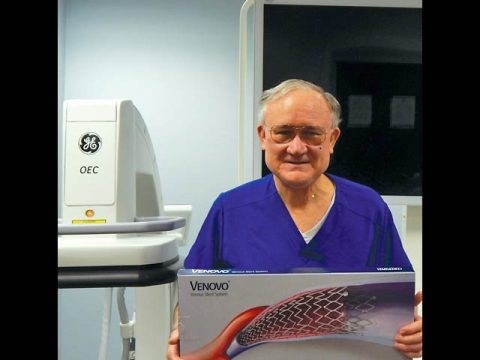By Tim Crawlield
I have practiced phleboloby for six years and I learned early in my career that patients with swelling in the lower extremities — swelling that cannot be contained by elastic graduated compression stockings — do not benefit from endovenous ablations.
My general rule of thumb is that if a patient’s lower extremity swelling is contained with elastic compression and CVI is suspected, then endovenous ablations should significantly improve swelling in the affected leg. I have encountered only a handful of patients throughout my practicing career who have partially responded to elastic compression stockings and have fared worse after endovenous ablations.
 Both calves were lightly erythematous, but without warmth or induration. There was no skin thickening or fibrosis in the lower extremities without a Stemmer’s sign. Wearing elastic graduated compression stockings partially reduced her swelling and discomfort, but she continued to have symptoms that interfered with daily activities. The duplex ultrasound of the bilateral lower extremities demonstrated axial reflux in the bilateral great saphenous veins.
Both calves were lightly erythematous, but without warmth or induration. There was no skin thickening or fibrosis in the lower extremities without a Stemmer’s sign. Wearing elastic graduated compression stockings partially reduced her swelling and discomfort, but she continued to have symptoms that interfered with daily activities. The duplex ultrasound of the bilateral lower extremities demonstrated axial reflux in the bilateral great saphenous veins.
She had technically successful endovenous ablations and was feeling well at her one-week evaluation. Several weeks after her procedures, she developed increased swelling, a “tight” discomfort in the calves and worsening erythema in the left leg. Her right lower extremity had done well and was asymptomatic, but her left leg now felt worse.
Repeated duplex ultrasound did not demonstrate residual superficial or deep vein disease, and she was unable to don her compression stocking on the left leg. A CT venogram of the pelvic veins was performed and the findings were unremarkable.
Although rare, I have seen similar episodes of increased swelling after endovenous ablations, without objective evidence of venous obstruction. As with these other rare episodes, typical causes of lower extremity swelling (e.g. congestive heart failure, pulmonary hypertension, iliac vein compression syndrome, residual chronic venous insufficiency, deep venous thrombosis, renal failure and hepatic failure) were excluded.

Asheekh A, et al published a study in 2017 reporting that 16 percent of patients had persistent swelling despite successful endovenous saphenous vein closure and iliac vein stenting. Although routine iliac vein stenting is controversial, the results of this study suggest that residual swelling after endovenous ablations can have little to do with the venous circulation.
I suspect that many cases of persistent swelling after vein ablations are due to phlebolymphedema. Chronic venous hypertension will increase pressure in the blood capillaries and increase peri-capillary fluid. E. Kaiserling reports “glomerular-like convolution of a few capillaries” that decrease shear-stress and promote transmigration of inflammatory immunocytes. The accumulation of antigens, foreign material, and immune complexes in the interstitial space causes chronic localized
inflammation, fibrosis and stagnant lymphatic flow.
A Stemmer’s sign is a classic diagnostic tool for lymphedema, but not a required one. Secondary lymphedema can often affect tissues in a “descending” or localized pattern. There can be affected areas in the leg that spare the skin thickening over the base of the second toe. Remember though, a negative Stemmer’s sign does not exclude lymphedema.

Pittaluga et al conducted a retrospective review of lymphatic complications after varicose vein surgery in 2012. Of 5,407 surgical limbs, 118 (or 2.2 percent) had lymphatic complications; however, the majority of these complications were a result of saphenous stripping and revision surgeries. There was a 0.5 percent lymphatic complication rate with isolated phlebectomies. Although they did not measure the rate of lymphatic complications with endovenous ablations, I suspect the complication rates are similar.
Pittaluga et al were also able to identify three factors that can increase risk for developing lymphatic complications after surgery: age, trophic skin changes and obesity. Pittaluga et al noted a 14.7-fold increase in lymphedema if the BMI was greater than 30 (31.4 percent vs. 5.4 percent). The group with lymphatic complications was also older (age 59 vs. 53) and had higher rates of C4-C6 disease (22 percent vs. 6.5 percent).
Failure of elastic, or circular-knit, compression stockings to contain lower extremity swelling is often my first clue identifying post-operative lymphedema. Higher protein loads in lymphatic fluid increase viscosity and require higher pressures for fluid egress. Changing from elastic bandages to short-stretch bandages increases working pressure, can decrease swelling and control patient discomfort.

Gauze rolls and cohesive bandages are an inexpensive short-stretch option, but the materials are difficult to apply without creases and often slip. Cotton tubular stockinettes and reusable short-stretch bandages (I use BiaForm, 5m rolls in varying widths) are more convenient for patients who have learned how to apply their own leg wraps.
For patients who have discomfort from uneven wrap-pressure distributions, padding may be required. An additional layer of open-cell foam (I use LympheSoft 12cm x 2.5m x 0.4cm) will often redistribute bandage pressures, increase patient comfort and help maintain position of the bandages.
Changing “April’s” compression stockings to short-stretch bandages reduced her swelling to normal levels. She now wears a Velcro compression garment daily on the left leg that contains her swelling and her right leg remains asymptomatic. Although this was not her expected outcome, her symptoms are now controlled, and she is now more active than before her treatments. We are fortunate to have a certified lymphedema therapist near our clinic, and I referred April to her for manual lymphatic therapy.
It seems venous and lymphatic circulations are inextricably tied. Lower extremity edema should be defined as lymphedema, regardless of its primary cause. Response to compression types would then be less related to disease classification and more related to lymph protein loads and an individual’s lymph transport capacity. It may be difficult to ascertain a patient’s underlying lymphatic health, especially in patients who have latent, or stage 0 lymphedema.
I now discuss the possibility of procedure-related lymphatic complications with patients I consider to be at risk: age greater than 60, BMI greater than 30 and presence of C4-C6 disease. VTN
Timothy Cawlfield, MD, is a phlebologist specializing in the treatment of vein disease at American Vein & Vascular Institute. As a general practitioner licensed to practice medicine in Colorado with specialties in vascular disease and family medicine, Dr. Cawlfield has a hospital affiliation with Parkview Medical Center in Pueblo, Colo.
SUGGESTED READING
1. Carlson J. Lymphedema and subclinical lymphostasis (microlymphedema) facilitate cutaneous infection, inflammatory dermatoses, and neoplasia: A locus minoris resistentiae. Clin Dermatol 2014 Sep-Oct;32(5):599-619
- Pittaluga P, Chastanet S. Lymphatic complications after varicose veins surgery: risk factors and how to avoid them. Plebology 2012;27(suppl. 1):139-142
- The diagnosis and treatment of peripheral lymphedema: 2013 consensus document of the ISL. Lymphology 2013 Mar;46(1):1-11
- Abouelkheir G, Upchurch B, Rutkowski J. Lymphangiogenesis: fuel, smoke, or extinguisher of inflammation’s fire? Experimental Biology and Medicine 2017 Mar; 8:884-895
- Alsheekh A, Hingorani A, Marks N, Ostrozhynskyy Y, Asher E. Clinical correlation with failure of endovenous therapy for leg swelling. Vascular 2017 Apr;25(3):249-252
- Farrow W, Phlebolymphedema — A Common Underdiagnosed and Undertreated Problem in the Wound Care Clinic. J Am Col Certif Wound Spec 2010 Apr 22;2(1):14-23
- Földi E, Földi M, Lymphostatic diseases. In Földi’s Textbook of Lymphology. 3rd ed. Munich, Germany: Elsevier; 2012. p. 175-218.
- Földi M, Chronic venous insufficiency. In Földi’s Textbook of Lymphology. 3rd ed. Munich, Germany: Elsevier; 2012. p. 374-384
- Kaiserling E, Morphological findings in lymphedema and tumors. In Földi’s Textbook of Lymphology. 3rd ed. Munich, Germany: Elsevier; 2012. p. 262-266.



